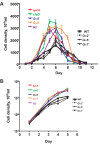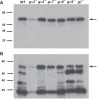A Dictyostelium chalone uses G proteins to regulate proliferation
- PMID: 19635129
- PMCID: PMC2726123
- DOI: 10.1186/1741-7007-7-44
A Dictyostelium chalone uses G proteins to regulate proliferation
Abstract
Background: Several studies have shown that organ size, and the proliferation of tumor metastases, may be regulated by negative feedback loops in which autocrine secreted factors called chalones inhibit proliferation. However, very little is known about chalones, and how cells sense them. We previously identified two secreted proteins, AprA and CfaD, which act as chalones in Dictyostelium. Cells lacking AprA or CfaD proliferate faster than wild-type cells, and adding recombinant AprA or CfaD to cells slows their proliferation.
Results: We show here that cells lacking the G protein components Galpha8, Galpha9, and Gbeta proliferate faster than wild-type cells despite secreting normal or high levels of AprA and CfaD. Compared with wild-type cells, the proliferation of galpha8-, galpha9- and gbeta- cells are only weakly inhibited by recombinant AprA (rAprA). Like AprA and CfaD, Galpha8 and Gbeta inhibit cell proliferation but not cell growth (the rate of increase in mass and protein per nucleus), whereas Galpha9 inhibits both proliferation and growth. galpha8- cells show normal cell-surface binding of rAprA, whereas galpha9- and gbeta- cells have fewer cell-surface rAprA binding sites, suggesting that Galpha9 and Gbeta regulate the synthesis or processing of the AprA receptor. Like other ligands that activate G proteins, rAprA induces the binding of [3H]GTP to membranes, and GTPgammaS inhibits the binding of rAprA to membranes. Both AprA-induced [3H]GTP binding and the GTPgammaS inhibition of rAprA binding require Galpha8 and Gbeta but not Galpha9. Like aprA- cells, galpha8- cells have reduced spore viability.
Conclusion: This study shows that Galpha8 and Gbeta are part of the signal transduction pathway used by AprA to inhibit proliferation but not growth in Dictyostelium, whereas Galpha9 is part of a differealnt pathway that regulates both proliferation and growth, and that a chalone signal transduction pathway uses G proteins.
Figures






Similar articles
-
The secreted Dictyostelium protein CfaD is a chalone.J Cell Sci. 2008 Aug 1;121(Pt 15):2473-80. doi: 10.1242/jcs.026682. Epub 2008 Jul 8. J Cell Sci. 2008. PMID: 18611962 Free PMC article.
-
Dictyostelium cells bind a secreted autocrine factor that represses cell proliferation.BMC Biochem. 2009 Feb 2;10:4. doi: 10.1186/1471-2091-10-4. BMC Biochem. 2009. PMID: 19187549 Free PMC article.
-
The ROCO kinase QkgA is necessary for proliferation inhibition by autocrine signals in Dictyostelium discoideum.Eukaryot Cell. 2010 Oct;9(10):1557-65. doi: 10.1128/EC.00121-10. Epub 2010 Aug 13. Eukaryot Cell. 2010. PMID: 20709790 Free PMC article.
-
Reconstitution of receptors and G proteins in phospholipid vesicles.Methods Enzymol. 1991;195:329-42. doi: 10.1016/0076-6879(91)95178-m. Methods Enzymol. 1991. PMID: 1851932 Review. No abstract available.
-
Cell density sensing and size determination.Dev Growth Differ. 2011 May;53(4):482-94. doi: 10.1111/j.1440-169X.2010.01248.x. Epub 2011 Apr 27. Dev Growth Differ. 2011. PMID: 21521184 Free PMC article. Review.
Cited by
-
Heterotrimeric G-protein signaling is critical to pathogenic processes in Entamoeba histolytica.PLoS Pathog. 2012;8(11):e1003040. doi: 10.1371/journal.ppat.1003040. Epub 2012 Nov 15. PLoS Pathog. 2012. PMID: 23166501 Free PMC article.
-
Altered protein secretion in Batten disease.Dis Model Mech. 2021 Dec 1;14(12):dmm049152. doi: 10.1242/dmm.049152. Epub 2021 Dec 6. Dis Model Mech. 2021. PMID: 34870700 Free PMC article. Review.
-
An Autocrine Proliferation Repressor Regulates Dictyostelium discoideum Proliferation and Chemorepulsion Using the G Protein-Coupled Receptor GrlH.mBio. 2018 Feb 13;9(1):e02443-17. doi: 10.1128/mBio.02443-17. mBio. 2018. PMID: 29440579 Free PMC article.
-
A retinoblastoma orthologue is required for the sensing of a chalone in Dictyostelium discoideum.Eukaryot Cell. 2014 Mar;13(3):376-82. doi: 10.1128/EC.00306-13. Epub 2014 Jan 3. Eukaryot Cell. 2014. PMID: 24390142 Free PMC article.
-
An Autocrine Negative Feedback Loop Inhibits Dictyostelium discoideum Proliferation through Pathways Including IP3/Ca2.mBio. 2021 Jun 29;12(3):e0134721. doi: 10.1128/mBio.01347-21. Epub 2021 Jun 22. mBio. 2021. PMID: 34154396 Free PMC article.
References
Publication types
MeSH terms
Substances
Grants and funding
LinkOut - more resources
Full Text Sources
Molecular Biology Databases

